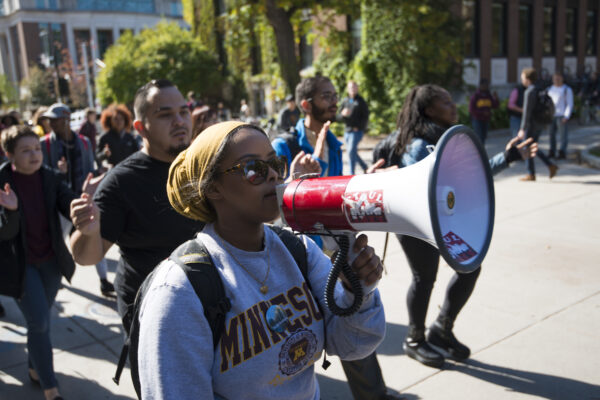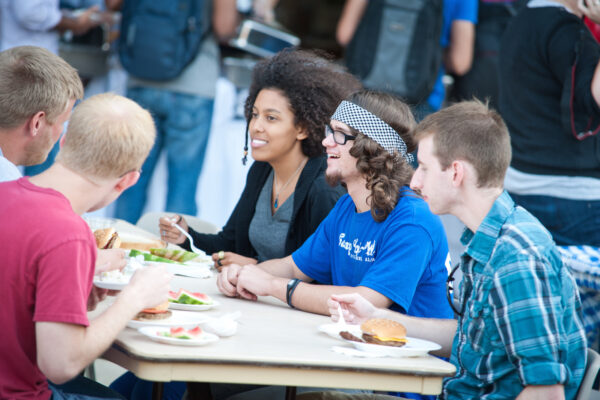By Dahlia Shaewitz and Jennifer R. Crandall
This post is part of the series Beyond the Margins: Meeting the Needs of Underserved Students.
Disability is inherently diverse—it is a category that includes people from every gender, race, culture, sexual orientation, geographic region, age group, and socioeconomic level. It’s also a group to which all of us can belong at any time. In 2016, one in four adults in the United States reported having a disability. This number increases to 40 percent for people age 65 and older.
Disability is part of the human condition. To ensure inclusion in higher education, campus leaders must consider how to fully embrace all students, faculty, and staff with and without disabilities. When developing a culture of inclusion, colleges and universities have specific responsibilities to students with disabilities to ensure they can learn and achieve their goals.
Creating a culture of inclusion
Disability is a campus-wide concern. Typically, campus leaders turn to the disability support services and counseling offices on campus to build a comprehensive approach to access and accommodations. While those offices have specific and critical responsibilities to support students, becoming an inclusive community takes work at all levels—from senior leadership, to faculty and staff, to students. Research indicates that if new students do not experience a sense of belonging within eight weeks of arriving at college, they will be at high risk of dropping out. This is particularly true for first-time students with disabilities, with 25 percent dropping out by end of year 1 and 35 percent dropping out by end of year two. Thus, shaping the culture of higher education institutions is one of the most important steps to achieving the goal of disability-diversity and inclusion.
Strategies for full inclusion on campus
Although no higher education institution has achieved full inclusion, many are striving to reach that goal. Drawing from a recent higher education inclusion guide on how to accommodate students while building a comprehensive culture of inclusion, we highlight specific action steps campus leaders can take and examples of institutions with supports in place for students with disabilities to achieve their highest potential.
Focus on campus design and planning. What does it mean to create a campus that is welcoming and safe for all students? It includes attention to campus facilities and other physical space. The design and accessibility of a space communicates values and expectations. Inclusive spaces, or designing for inclusivity, takes into account the different ways in which we learn, work, and socialize.
At Gallaudet University, an institution committed to the intellectual and professional advancement of the deaf and hard of hearing, attention to campus design and planning is critical. DeafSpace, a design approach to physical space developed at Gallaudet, “considers the sensory world where vision and touch are a primary means of spatial awareness and orientation.” Primary concepts include sensory reach, space and proximity, mobility and proximity, light and color, and acoustics.
Reflect on how language is used. How we refer to disability and people with disabilities can be limiting. One way to change detrimental attitudes or stigma toward disability is to intentionally use more inclusive language that dignifies people’s images and expectations. Using positive images of students with disabilities from different backgrounds can also help to familiarize disability.
Talking about disability and using inclusive language starts with how we define socially constructed concepts such as disability, diversity, and inclusion. Are you, your staff, students, or faculty nervous when talking about disability? Do members of your campus community either behave differently or feel they need to behave differently around students with a disability? How is disability portrayed on your campus or at your institution?
Ferris State University defines diversity to include disability: “Diversity is the range of human differences, including but not limited to race, ethnicity, gender, gender identity, sexual orientation, age, social class, physical ability or attributes, religious or ethical values system, national origin, and political beliefs.” Coupled with their definition of inclusion, Ferris State sets expectations that all people are valued and respected for their talents, beliefs, backgrounds, and ways of living.
Build faculty capacity. Faculty may lack an understanding of inclusive pedagogy, so it is important to talk about disability bias and raise awareness about common disabilities. Faculty are likely to adopt inclusive teaching methods and materials if they are more knowledgeable about disability and understand that students with disabilities have limitations that arise from external barriers and not students’ inherent abilities. Students with learning disabilities, for example, do not have a reduced intellectual capacity. Rather they may have processing disabilities that can be addressed by the format in which information is conveyed, organizational mechanisms such as testing procedures and methods, and other tools. In addition, faculty can initiate conversations with students about supports they may need, or encourage them to consider the ways they learn best.
“I would say the biggest barrier for me going through college was ableism from professors. Much of it was subconscious ableism, like forgetting that VHS tapes used as class material don’t have captions,” said Kirsten Hernandez, currently a graduate student at California State University (CSU)-Long Beach. [While] “it was addressed as soon as I brought it to their attention, [s]ome of it was willful and repeated ignorance. One professor I had in my senior year of undergrad told us on the first day of class that she wouldn’t allow ASL interpreters or CART providers in her class because she was “distracted” by them (which, yes, is very illegal).”
Portland Community College offers an array of online accessibility training opportunities for staff and faculty. While these resources are geared toward faculty creating accessible content for online classes, they are relevant for any form of instruction that uses multiple mediums (e.g., documents, audio, video). Included are tutorials, accessibility guidelines, and syllabus templates.
Ensure technology is accessible. Institutions should have a clear standard for accessibility when it comes to technology. The recommended standard from the U.S. Access Board is the Web Content Accessibility Guidelines 2.0, Level AA, which, until 2017, surpassed the 508 compliance standards for federal agencies. These guidelines include making captioning a standard element of all videos used in classes and on campus, providing a budget for creating video captions, and requiring that all new content posted to a website meet the accessibility standard and establish accessibility checkpoints before content can be posted.
The CSU system created the Accessible Technology Initiative (ATI) to facilitate access to information technology resources and service for all CSU staff, faculty, students, and the general public. This comprehensive initiative is built on the belief that technology accessibility is a campus-wide responsibility, that technology access must offer comparable functionality, affordability, and timeliness, and that Universal Design principles should be used. The initiative also has an ATI Communities of Practice for CSU employees.
“I would suggest college leaders/admin to ask themselves this question before they plan their classes and programs,” said Hernandez. “How will this lesson work for students with disabilities? Doing a small mental checklist and double checking to see if their materials are accessible would really make a difference for a lot of students. While things like non-captioned videos and scanned materials rather than text files might not seem like a big deal to many, it prevents some from getting the full education they deserve.”
Encourage responsibility and accountability. Leaders at all levels should be engaged in leading, messaging, and measuring improvements in inclusion. All staff should clearly see their own role in, and contribution to, inclusiveness. On-the-ground action among faculty, staff, and students needs to happen in tandem with support at the level of the president, dean, chancellor, or provost who embrace disability-diversity consistently and publicly.
The strategy, goals, and objectives of Landmark College in Vermont, according to President Peter Eden, “are grounded in the understanding that many students not only learn in different ways but they tend to succeed when provided a learning and living environment that differs from often rigid and conventional higher education models.” This disability-diversity ethos is driven by a mission to serve students with learning disabilities through accessible, evidence-based approaches to learning and built on commitments from stakeholders across the institution.
Streamline the student accommodation process. Common reasonable accommodations in higher education include changes to course formats and schedules, examination accommodations, housing changes (e.g., permitting emotional support animals in housing or offering separate housing for people with post-traumatic stress disorder or gender dysphoria), alternative methods of demonstrating or obtaining practical skills, and extra time to complete projects.
Part of managing the student journey is ensuring that students and faculty understand the process for learning about, requesting, receiving, and modifying requests for accommodation. Effective, user-friendly solutions for students also create opportunity for the accommodation team, including faculty, to increase their level of service. Institutions need to understand how learning can be impaired by not tending to inclusive practice and accommodation for students with disabilities. Are your accommodations designed simply to pass the ‘reasonableness’ test or does your institutions strive to support learning for all through inclusion? Do you allow for increased flexibility in delivery? Is there variety in how learning is designed and delivered? Does increased interaction with faculty and staff meet the needs of students with disabilities when it needs to?
The Disability Programs and Resource Center (DPRC) at San Francisco State University is a one-stop shop on ensuring full and equal access to university programs and facilities. Included in its comprehensive approach to disability is myDPRC, a web-based application for managing the accommodation process for students. Students, faculty, and DPRC staff have access to the portal and are updated in real-time. A training portal also provides tutorials for faculty on the alternative testing process and for students on how to register with and navigate myDPRC and how to request and modify accommodations.
Culture is shaped by the attitudes of administration and faculty and the lens through which disability is viewed. Even when students do not experience outright hostility, stigma and generalizations are likely to be the most prevalent barriers in the path of students with disabilities. To counteract common biases against students with disabilities while creating an inclusive campus culture, leaders at all levels of the institution must get involved. Inclusion on campus helps everyone to understand the common interests, goals, and aspirations of people with and without disabilities. Students benefit from a diverse, inclusive campus culture, which helps prepare them for the world of work and civic and community engagement.
How will your campus or institution build a comprehensive culture of inclusion?
If you have any questions or comments about this blog post, please contact us.


